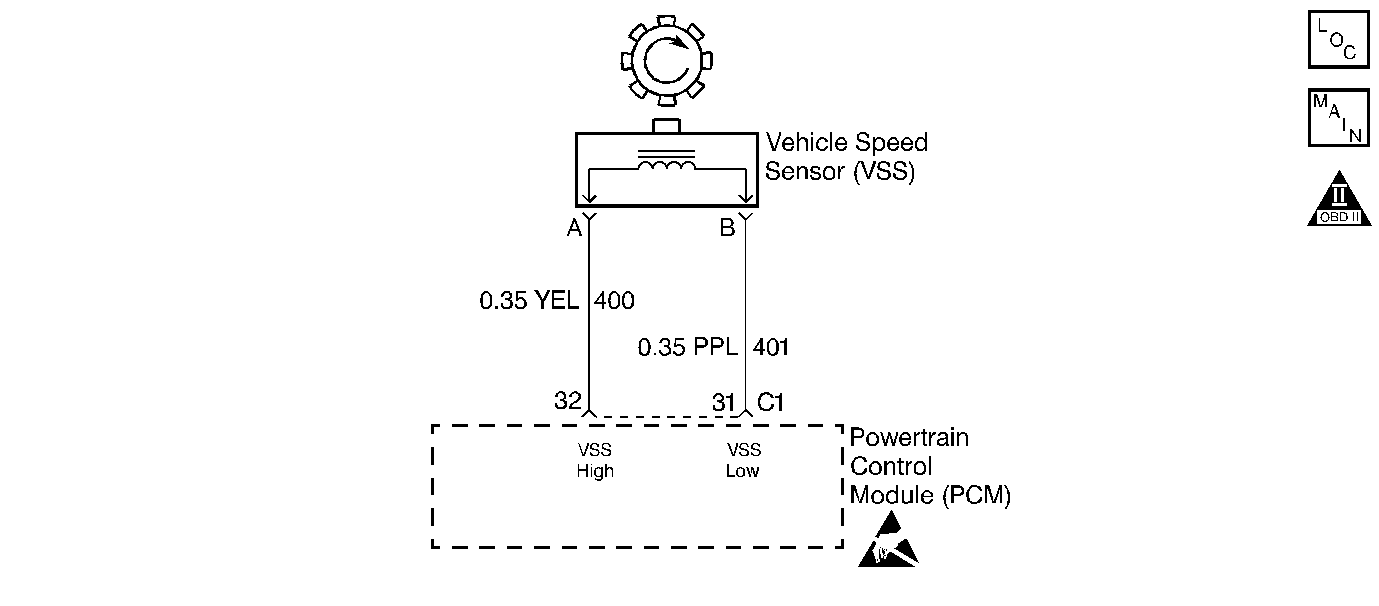
Circuit Description
The VSS provides vehicle speed information to the PCM. The VSS is a Permanent Magnet (PM) generator. The VSS produces a pulsing AC voltage. The AC voltage level and the number of pulses increase as the speed of the vehicle increases. The PCM converts the pulse to vehicle speed. A scan tool can display the vehicle speed.
DTC P0502 detects a low vehicle speed when there is a high engine speed in a drive gear range. DTC P0502 is a type A DTC.
Conditions for Setting the DTC
| • | No MAP DTCs P0107 or P0108 |
| • | No TP DTCs P0122 or P0123 |
| • | No TFP Valve Position Switch DTC P1810 |
| • | Not in Park or Neutral |
| • | The TP angle is greater than 17%. |
| • | The engine vacuum is between 50 and 80 kPa. |
| • | The engine speed is between 3000 and 5500 RPM. |
| • | The transmission output speed is less than 250 RPM. |
| • | All conditions met for 3 seconds |
Action Taken When the DTC Sets
| • | Second gear only |
| • | Maximum line pressure |
| • | The freeze shift adapts from being updated. |
| • | The PCM inhibits TCC Solenoid Valve engagement. |
| • | The PCM illuminates the Malfunction Indicator Lamp (MIL). |
Conditions for Clearing the DTC
| • | The PCM turns OFF the MIL after three consecutive ignition cycles without a failure reported. |
| • | A scan tool can clear the DTC from the PCM history. The PCM clears the DTC from the PCM history if the vehicle completes 40 warm-up cycles without a failure reported. |
| • | The PCM cancels the DTC default actions when the fault no longer exists and the ignition is OFF long enough in order to power down the PCM. |
Diagnostic Aids
| • | A VSS DTC P0502 will set when no vehicle speed is detected at start OFF. |
| • | Inspect the wiring for poor electrical connections at the PCM. Look for the following conditions: |
| - | A bent terminal |
| - | A backed out terminal |
| - | A damaged terminal |
| - | Poor terminal tension |
| - | A chafed wire |
| - | A broken wire inside the insulation |
| • | When diagnosing for an intermittent short or open condition, massage the wiring harness while watching test equipment for changes. |
| • | Test circuits 400 and 401 for Electromagnetic Interferences (EMI) induced by a wiring harness incorrectly routed too near the spark plug wires. |
Test Description
The numbers below refer to the step numbers on the diagnostic chart.
-
You must disable the traction control system in order to perform this step. The traction control system turns ON if the ignition switch is cycled OFF then ON. Ensure that you have disabled the traction control system.
-
This Step verifies the integrity of the VSS.
-
This Step verifies the integrity of the VSS circuit.
-
This Step verifies the 5-volt reference voltage on circuit 400.
Step | Action | Value(s) | Yes | No |
|---|---|---|---|---|
1 | Was the Powertrain On-Board Diagnostic (OBD) System Check performed? | -- | Go to Powertrain On Board Diagnostic (OBD) System Check , Section 6E | |
Important:: Before clearing DTCs, use the scan tool in order to record Freeze Frame and Failure Records for reference. The Clear Info function will erase the data. With the drive wheels rotating, does the Trans Output Speed increase with the drive wheel speed? | -- | Go to Diagnostic Aids | ||
Is the voltage measurement greater than the specified value? | 0.5V | |||
4 | Ensure that the most recent calibration is correct. Is the calibration current? | -- | ||
5 | Reprogram the PCM. Refer to Powertrain Control Module Replacement/Programming , Section 6E3. Has the PCM been reprogrammed? | -- | -- | |
Measure the resistance between the harness connector terminals C1-31 and C1-32. Is the measured resistance greater than the specified value? | 1825ohms | |||
7 | Inspect circuits 400 and 401 for a poor connection or an open circuit. Repair the circuits if necessary. Refer to Electrical Diagnosis, Section 8A. Did you find and correct a problem? | -- | ||
8 | Is the resistance measured between the harness connector terminals C1-31 and C1-32 less than the specified value? | 1150ohms | ||
9 |
Refer to Electrical Diagnosis, Section 8A. Did you find and correct a problem? | -- | ||
10 |
Is the measured resistance within the specified range? | 1150-1825ohms | ||
Is the measured voltage within the specified range? | 4-5V | |||
12 |
Did you find and correct a problem? | -- | ||
13 | Replace the VSS. Refer to Vehicle Speed Sensor Replacement. Is the replacement complete? | -- | -- | |
14 | Replace the PCM. Refer to Powertrain Control Module Replacement/Programming , Section 6 Is the replacement complete? | -- | -- | |
15 |
Has the test run and passed? | -- | System OK |
